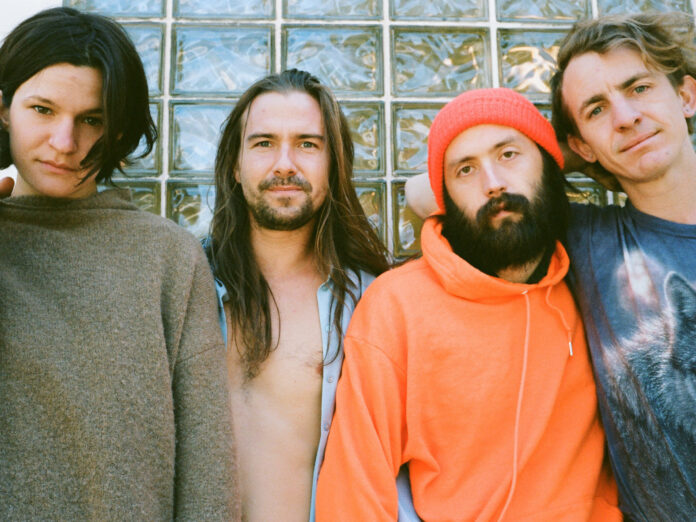A list, at the end of 2022:
Lots of indie rock tentpole artists come and go, and even when I carry their music down the line it’s hard for me not to connect them with their era and how I felt at the time. I could see this happening with Big Thief, but at least right now, they feel like the real thing. They got all their experimentation out early on, and what they’ve settled on with their awkwardly named double album feels like a new core for their sound, moving away from the courant wave of empathy-rock towards something that nods just subtly enough at the American roots tradition to be recognizable as such without ever breaking their pall of shyness to crack a folksy smile.
In other words, they haven’t suddenly turned into Dan Hicks and his Hot Licks, but the sense of domestic freakhood is unmistakable. See “Certainty,” a song that takes on even more resonance when you realize it’s written by a former couple, where romance, action, and mystery are Netflix channels but also more than that. Or “Red Moon,” where Adrianne Lenker sings to the onions she’s cooking in a voice that’s become twangier and more Emmylou Harris-like with each record. And “Sparrow,” which roots the origins of her fascination with nature in the biblical birth of woman (“she talks to snakes and they guide her,” she sings, referring both to Eve and her own songwriting).
Throughout it all, Lenker sings in a sort of elevated rock talk, using bluesy idioms like “mama” and “rolling stone,” embracing the blues in a way a lot of indie rockers refuse to either out of racial embarrassment or residual memories of Blueshammer. A lot of latter-day roots-rock is insufferable because it sees the music as a gateway to some kind of authenticity that’s really just the affectation of looking and sounding poor. Lenker and her crew keep the affectations that suit them and throw out the ones that would look bad on them, and their music has heft not because it’s “authentic” but because it’s genuinely inspired. Hell, even the uninspired music works, because they keep Dragon from being the single masterpiece towering over the rest of their discography and crowding out the other great albums they’ve made.
This is a band that’s been working at a fearsome level of consistency for a while, and if Dragon makes it higher on my list than any other Big Thief album in the past, it’s because it has the best songs.
2. MORE EAZE, STRAWBERRY SEASON
More Eaze is my favorite of the young generation of field-recordists and sound-collagists, most of them queer, Internet-savvy, and intensely concerned with the end of the world. Yet her new album Strawberry Season hearkens back to an older era of music that expresses apocalyptic unease about industry and technology—with Grandaddy’s The Sophtware Slump and the two great Flaming Lips albums that bookend Y2K as precedents, rather than the hyperpop in which More Eaze has indulged in the past.
Tellingly, More Eaze has worked with Dntel, whose music as the producer half of the Postal Service perfected a kind of pop based around the idea that a robot can make big bug eyes at you and be just as lovable as a human. Strawberry Season sees a tentative kind of good in a hyper-stratified world, from the eldritch but indispensable existence of dogs to the hellish terraforming required in order to keep food in stores year-round.
3. BIOSPHERE, SHORTWAVE MEMORIES
You understand how a mountain climber could make something like this. Geir Jenssen’s latest work is a cold, immovable, formidable, and essentially meaningless album that stands in front of the listener and presents an arduous challenge that offers exhilaration and hard-earned endorphins as a reward. It’s the kind of thing you make in full control of your powers, when your reputation precedes you and you can do what you want, and it’s the best album in 10 years from a first-generation ambient-techno artist whose current wilderness period had yet to spit something out this good when Shortwave Memories surfaced with little fanfare earlier this year.
4. SHINICHI ATOBE, LOVE OF PLASTIC
Shinichi Atobe continues to do no wrong. His streak since emerging from a long and mysterious hiatus in 2014 has cemented him as one of electronic music’s most interesting artists, with such a weird and counterintuitive touch in the studio that his music sounds like the elements banged it together out of tattered beach debris. His new one is his most accessible and upbeat, with fewer obstinate loops and trials by fire and more songs that would actually go off in the club than usual. It’s a great album not because of how strange it is but because of how well-made and beautiful it is, with all its echoing pianos and sighing chords and amoebic synthesizer squiggles.
The songs on Florist are fine, nothing I’d give much further thought to if I heard them out of context, and “Red Bird Pt. 2 (Morning)” is so saccharine I almost gave up on the album the first time around. What makes the New York band’s new self-titled sprawler so great is the overall environment, the way it sounds open to nature (“June 9th Nighttime” is so suggestive of the lonesome sounds of the night you forget there aren’t actual wolves howling on it), the way the songs and the instrumental interludes bleed into each other and contribute to the album’s sense of weird and fantastical natural architecture. This is the year’s great organic-wonderland album.
I topped my Tone Glow year-end list with “Daryl Groetsch – Bandcamp albums,” refusing to pick from the seven good-to-amazing albums he’s put out this year, but for the sake of variety I’m narrowing it down to Home Again, the best of his self-released synth series under his birth name (he usually records as Pulse Emitter). I’ve never heard ambient music this minimal that elicits such a strong emotional response, and with just a few simple synth tones he suggests a comfort that defines itself in opposition to weariness and trouble and sadness. It’s new-age music that doesn’t pretend the universe is good but instead knows how bad it can be and offers a reprieve.
7. ACTRESS, “DUMMY CORPORATION” EP
The title track is the main attraction here, and it satisfies my craving for endless-city cyberpunk voluptuousness. Actress usually makes sharply sound-designed, tightly compressed, frequently head-twisting techno, but the gravitational field that usually holds his production together has slackened, and “Dummy Corporation” spills out over 19 minutes of muffled kick drum and house chords that spread so generously across the stereo field they create the illusion of a protective cocoon ensconcing the listener. The other three tracks are all solid, but they’re more for DJs than listeners, so consider this my vote for Track of the Year with a few extra songs thrown in.
8. THE SOFT PINK TRUTH, IS IT GOING TO GET ANY DEEPER THAN THIS?
A luxurious reprieve from Drew Daniel’s usual routine of asking questions and furiously attempting to answer them, the newest and longest Soft Pink Truth album plays as if Daniel’s given himself a vacation from wrestling with intellectual and moral quandaries and simply pooled his resources to make a great disco album. The one-time San Franciscan has been making music for 30 years, both alone and with M.C. Schmidt as Matmos, without indicating that there’s a task he can’t put his mind to. Here he enlists his friends to craft an epic so spic-and-span, so well-done, and so enjoyable to listen to that it feels exciting in spite of its relative mindlessness.
9. BURIAL, “ANTIDAWN/STREETLANDS“
“Ambient Burial” is basically the sweet spot of my music taste, and here are the two most sustained examples even though they don’t approach the realm of pure misty grayscale abstraction I’ve always dreamed of from a project like this. Antidawn is a bit too oblong for my liking, Streetlands a bit too enamored with its harsh and distracting sequencers, and they don’t work as well slammed together one after the other in a playlist as they will on the inevitable Tunes 2020-2029 compilation at the end of the decade. If Burial expands on the formula of these EPs, and I suspect he will, he could knock them off my list. Consider this a placeholder.
10. DAPHNI, CHERRY
The best album yet from Caribou mastermind Dan Snaith’s rave project reflects the kind of total abandon I hardly expected from a man who’s spent half his life making critically-acclaimed indie rock albums. If it feels like any kind of rock, it’s Oblivians-style garage-trash—these tracks seem so bashed-together that I’d half-believe it if you said he made this in one night while coming down from who-knows-what, desperate to get his hands moving and indifferent to results. Yet somehow they arc into a proper dance epic, like an Atobe album on crack, even including the weepy late-album epic (“Cloudy”) that feels here like both a parody and a perfection of the form.
SPECIAL HONORABLE MENTION: NYOKABI KARIŪKI, PEACE PLACES: KENYAN MEMORIES
I don’t so much enjoy listening to this album and I don’t see myself returning to it with much regularity except as a reference point, but it gets to the heart of a theory I’ve entertained for the last few years about the new wave of “emo-ambient” field-recording music—that twentysomething and thirtysomething artists’ lives are so transient and unstable right now that there’s a need for a form of music that can give the artist and the listener a sense of mastery over time. Field recording is a way of doing that, of suspending a moment forever, just like a photograph—and just as Andy Guthrie’s incredible Gyropedie from last year, which documented a cross-country journey financed by the gradual selling of the instruments heard on the album—so did Peace Places allow Kariūki to assemble field recordings of her native Kenya into a simulacrum of the place even while she was stuck in the States during COVID. I’m less moved by the content of the album itself than by the idea of Kariūki herself returning to this music when she feels homesick.
OTHER ALBUMS I ENJOYED FROM THE YEAR:
William Basinski and Janek Schaefer’s …On Reflection, a verdant ambient album whose margins teem with life; Destroyer’s Labyrinthitis, one of the great Vancouver band’s most complete and cryptic statements; James Devane’s Beauty Is Useless, a gust of ambient techno strong enough to knock you over; Alex G’s God Save The Animals, made by one of America’s best rock songwriters at something close to his peak; Fievel Is Glauque’s Flaming Swords, rigorously played and conceived but fun and even somehow humble; Johan Graden and Ellen Arkbro’s I Get Along Without You Very Well, an icy and gorgeous little pop album by two Nordic artniks; Mister Water Wet’s Significant Soil, a strange little artifact whose music seems cut out from scraps of paper; Raum’s Daughter, a tribute to the joys of watching weird movies with your friends; Kurt Vile’s Watch My Moves, all golden-hour skies and shaggy-haired poetry; and Levon Vincent’s Silent Cities, a desolate vision of a depopulated urban landscape reclaimed by nature.





